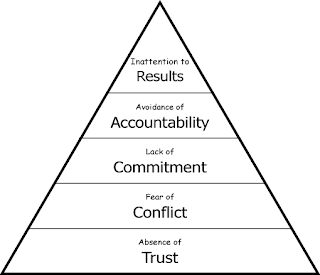This is the second of a five part series on high
performance teamwork, based on the book, The Five Dysfunctions of a Team by Patrick Lencioni. The five major dysfunctions that Lencioni has
identified, which is backed up by the research are:
*Absence of Trust
*Fear of Conflict
*Lack of Commitment
*Avoidance of Accountability
*Inattention to Results
Fear of Conflict cannot be overcome without trust
– so check out the prior blog here if you missed that.
Once you have a team that trusts one another, then
leaders need to role model what constructive conflict looks like. All too often, people are conflict
avoidant. Conflict does not have to be
nasty and, in fact, constructive conflict makes a team stronger.
When a team member makes a suggestion, many people
will hesitate to say something even if they think it is a bad idea. But high performing teams know that they will
only make the optimal choices if they get many ideas on the table and evaluate
all of them. So, as a leader who wants
to role model constructive conflict you can say things like:
“Thanks for your idea, Rob. What do the rest of you think? Let’s brainstorm at least five different
possibilities before we make any decisions.”
Another simple technique is to break your team
into two or three sub-groups and have them brainstorm ideas to bring back to
the full team. I often do this in
strategic planning sessions to encourage divergent thinking. You can also take care to carefully assign
people to subgroups who may have differing opinions.
If you are going to role model constructive
conflict it is vital that you react appropriately when someone suggests an
alternative to your latest
brilliant idea. If you can do that and
encourage others to do the same, then you are on your way to becoming a high
performing team that makes an exceptional Mission
Impact.
For more ideas on how you can lead
breakthroughs in your organization, follow this blog and check out my web site
at www.SheehanNonprofitConsulting.com You will find free resources you can
download, including a Breakthrough Strategy Workbook that you can download at
no cost. You can also check out my book,
Mission Impact: Breakthrough Strategies
for Nonprofits, and buy it if you are interested. And you can follow Sheehan Nonprofit
Consulting on Facebook.

